An omnichannel customer experience seamlessly integrates all customer touchpoints and channels to deliver a consistent, unified and personalized interaction throughout the customer journey with your brand.
It’s not a secret that customers base their purchases on more than just product and price — customer experience has overtaken them both. Customers expect immediate and personalized service on their preferred digital channels, such as social, live chat, chatbots, and messaging apps.
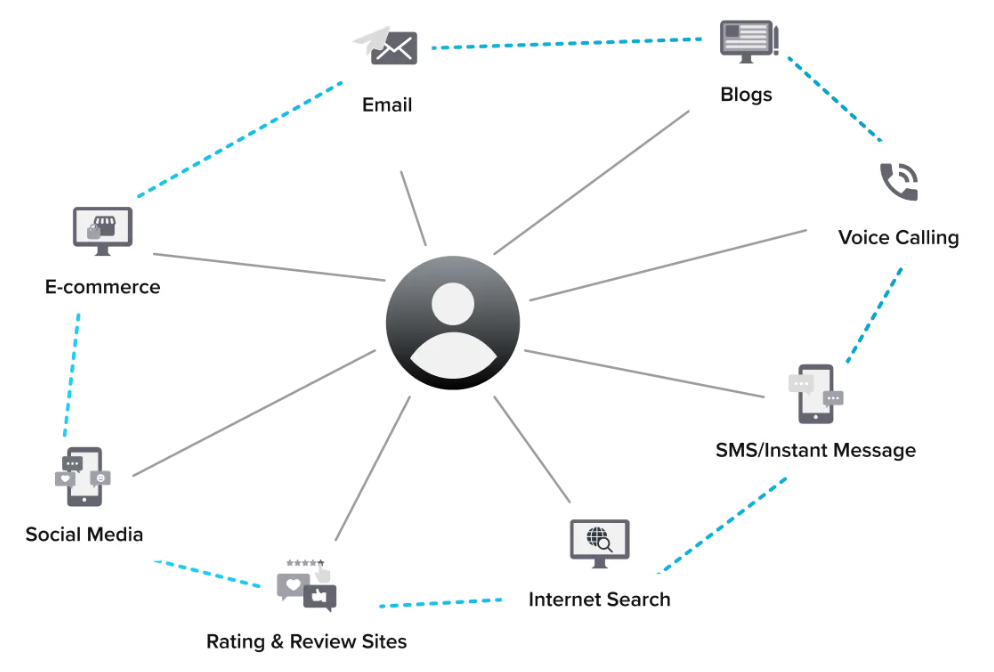
From the customer's perspective, engagements with a business should feel cohesive, not fragmented, as often seen in multichannel contact centers. Integrating every channel, digital and physical, ensures a harmonized and unbroken omnichannel journey.
Why is omnichannel customer experience important?
With the proliferation of digital communication channels, it has become important for brands to offer a consistent customer experience. A disjointed experience can confuse and deter customers from deepening their engagement with a brand or returning to it over and over. By adopting an omnichannel customer experience, you can ensure uniformity across all touchpoints, which not only solidifies customer trust but also positively impacts your bottom line. When interactions feel streamlined, customers are more likely to continue their relationship with your brand, boosting customer retention and revenue for you.
Imagine a scenario: A customer purchases headphones from a brand's website but encounters an issue upon delivery. If this customer reports the problem via WhatsApp, an adeptly integrated omnichannel system instantly pulls up the order details — regardless of where and how the customer first placed the order. This fluid cross-channel integration eliminates redundant back-and-forth, ensuring swift, precise resolutions that elevate your customer satisfaction.

Omnichannel vs. Multichannel customer experience
Aspect | Multichannel customer experience | Omnichannel customer experience |
Objective | Interact with customers across multiple channels | Provide a seamless and integrated experience across all channels |
Customer Journey | Each channel operates in isolation; disjointed transitions between them | Every interaction is consistent and fluid, without losing context, regardless of the channel |
Data Sharing | Often siloed; each channel has its own set of data | Integrated data; all channels share the same customer information |
Consistency | Inconsistencies might arise between channels | Consistent branding, messaging and service across channels |
Personalization | Channel-specific insights drive limited and isolated personalization | Comprehensive data integration informs real-time, adaptive personalization across all touchpoints |
Technological Foundation | Individual tech stacks for each channel | Unified platform that integrates all channel technologies |
Customer View | Typically fragmented, brands see multiple profiles for the same customer across channels | Single, holistic customer view regardless of interaction channel |
Efficiency | Resolutions can be slower due to a lack of integrated data | Consistent data sharing ensures both customers and brands are aligned, streamlining resolutions |
4 Benefits of omnichannel customer experience
Customer touchpoints have multiplied, but fragmented experiences erode trust. Omnichannel experiences bridge this gap and yield benefits like:
Better customer engagement: With omnichannel customer service, you can meet customers 24x7 on their preferred channel. This maximizes your chances of reaching a broad and diverse audience through contextual content.
More customer convenience: An omnichannel customer experience prioritizes user convenience by eliminating the need for repeated information sharing across touchpoints. It significantly improves your customer effort score when your users encounter fewer friction points and bypasses frustration in finding answers.
Improved customer loyalty: Every single interaction matters and the level of personalization and consistency you can provide across channels and devices increases customer satisfaction, resulting in repeat business and happier customers.
Actionable insights: You can be on top of customer concerns through a holistic view of your customers’ social activities, chats, emails, community discussions, survey results, case history and CRM data — all to provide rich data to your sales and marketing teams to deliver high-performing ad campaigns.

How to create an omnichannel customer experience
Driving an omnichannel experience strategy in your business needs a customer-centric pivot. Here are the steps you can follow to create an omnichannel customer experience in your business.
1. Mapping your customer journey
To create an omnichannel experience, it’s vital to first understand the customer journey your target audience takes, from the first point of contact to post-purchase touchpoints. The customer journey map highlights potential pain points, opportunities and moments of truth across channels. By understanding this journey, brands can ensure they're present at every critical juncture, offering a seamless experience.
Construct buyer personas to pinpoint customer attributes, preferences and behaviors
Draft a flowchart or diagram that visualizes all touchpoints a customer has with your brand, from discovery to purchase to after-sales support.
Look for areas where customers might get frustrated due to lack of information or support and channels where repeated or redundant information is being pushed.
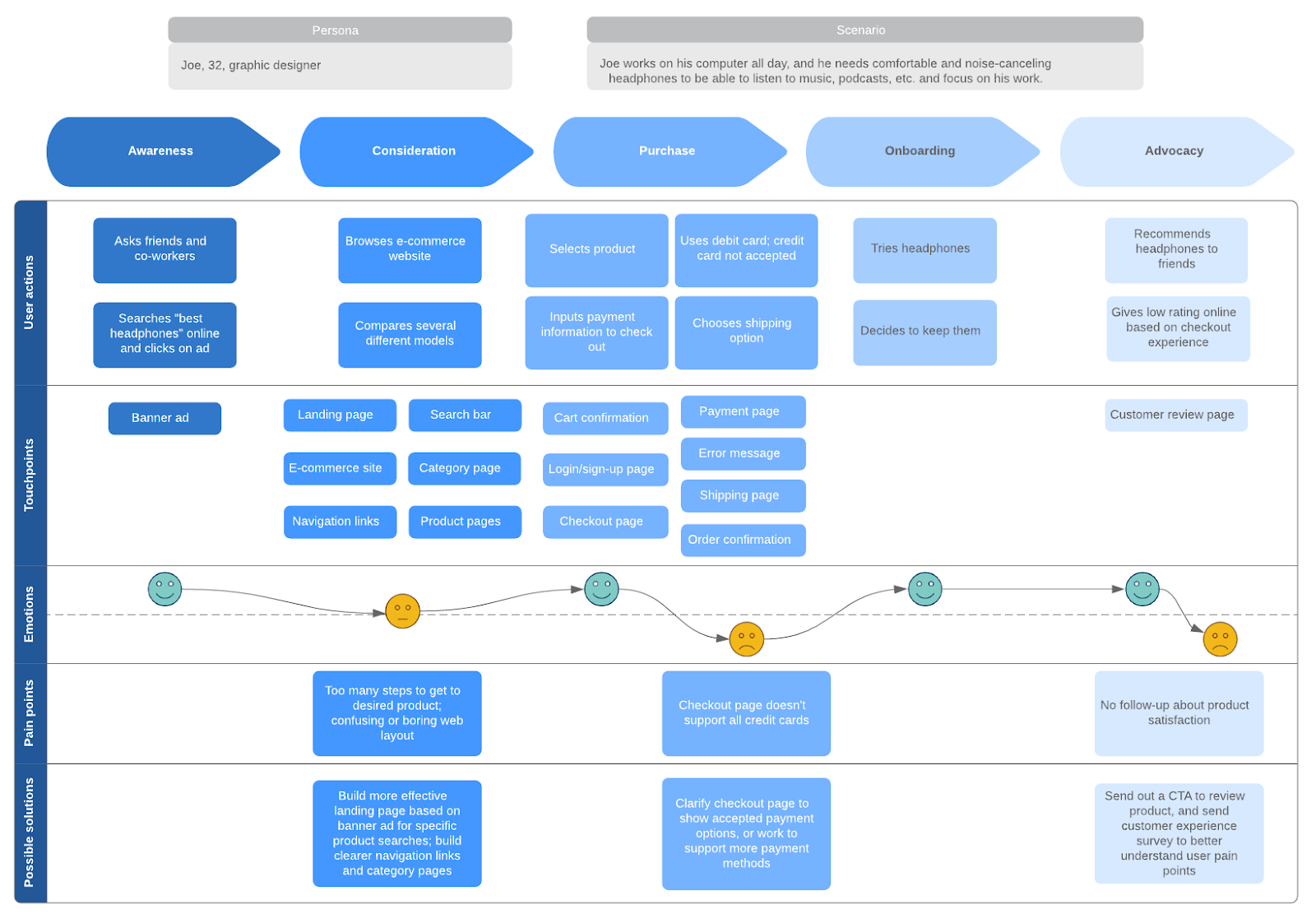
2. Synthesizing multi-channel feedback
Understanding your customers' preferences and pain points across every interaction point is crucial. Whether it's a brick-and-mortar store, a website, a mobile app, or social media platforms, every touchpoint provides valuable insights.
Implement feedback mechanisms across channels: use website pop-ups, in-app customer surveys and social media polls.
Utilize data analytics tools to collate and analyze feedback data, helping you identify recurring themes or issues.
💡Pro tip: Today, there are omnichannel customer survey software that can customize your survey for multiple channels with zero manual effort. The surveys are customized to each channel’s technical specs and adherent to your brand voice. Go ahead and use omnichannel surveys to access your customers' voices wherever they choose to engage with you.
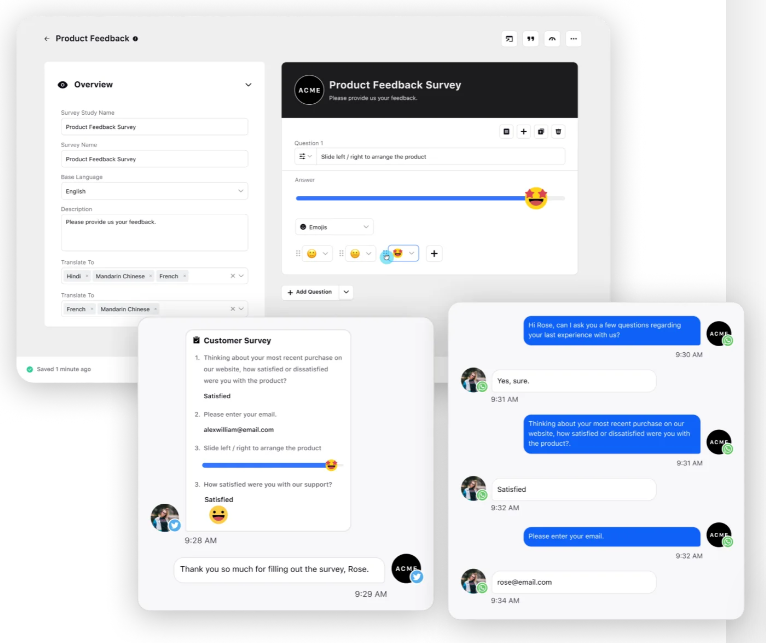
3. Focusing on personalization
To stand out and create a genuine connection, brands should use the data they collect to offer personalized experiences. This can include product recommendations, tailored content or exclusive offers based on past interactions.
Implement an omnichannel tool that helps you build a single view of the customer
Implement AI to suggest products or services based on a customer's purchasing history, past support tickets and social activities.
Segment your email list to send tailored content and offers to specific customer groups.
Personalization is just the starting point. The goal is to cultivate loyal customers who feel understood. Check out the conversation we had with Adobe to understand how they (and now, you) transform raw data into sharp customer insights.
4. Building a dedicated team
The complexity of managing an omnichannel experience requires a dedicated team. This team should be interdisciplinary, comprising experts who understand the nuances of different channels.
Assemble a team with members from IT, marketing, customer support and product departments.
Set up regular team meetings to discuss findings, challenges and strategize solutions.
5. Building an integrated infrastructure
The technology backbone of omnichannel customer experience should seamlessly integrate various channels, ensuring that the user's transition from one channel to another is smooth.
Use omnichannel software that allows seamless integrations with CRM and ERP systems that can unify customer data across channels.
Ensure all customer-facing platforms (like websites and apps) are mobile-optimized and user-friendly.

6. Crafting a unified messaging strategy
Consistent messaging across all channels reinforces brand reliability. It's essential to ensure that advertising campaigns, product information and customer support remain consistent, regardless of where the customer interacts with the brand. Take a look at this three-step process to develop and refine your messaging strategy:
Step 1: Content audit and inventory
Review content across channels, including the website, mobile app, social media, and print.
Catalog and evaluate each item for its tone, purpose and message.
Step 2: Centralized brand guideline
Develop a guideline detailing the brand's voice, tone and terminology to ensure consistent communication.
Incorporate both visual elements (like logos and colors) and textual aspects (such as catchphrases and product descriptions.)
Step 3: Review and iterate
Periodically evaluate the consistency and impact of your brand messaging.
Gather feedback from teams, identify inconsistencies and refine the strategy based on insights and evolving objectives.
💡Pro tip: Ensure your team sings a cohesive tune with a content plan that ensures brand compliance. Use a content marketing platform to:
Strategize global omnichannel campaigns with a unified view of calendars, assets and analytics.
Go beyond just content creation; implement mandatory approval flows and activity audits for quality control.
With a central workspace, set the gold standard by defining governance rules, controlling publishing permissions and ensuring every piece aligns with your brand’s voice.
7. Training staff for omnichannel proficiency
Your staff should be equipped to handle customer queries originating from any channel. Their training should emphasize an integrated brand experience. Here are many ways you can use customer service coaching to ensure agents are proficient in using multiple channels.
Training sessions: To highlight the importance of a consistent customer experience.
Simulation scenarios: where employees can practice managing cross-channel queries.
Peer-to-peer coaching: Allow new staff to observe experienced members during real customer interactions across channels.
Gamification: Organize challenges where team members need to collaborate across functions to solve a specific customer issue using multiple channels.
Step-by-step channel guides: Create playbooks detailing best practices and troubleshooting methods.
Omnichannel presence doesn’t equate to the 24/7 physical availability of your teams. There are advanced tools that enable smart scheduling and SLA setting for different channels, ensuring business continuity in after-hours and holiday seasons.

8. Regularly reviewing and adapting
The digital landscape and customer preferences are always evolving. Regular reviews ensure that your omnichannel customer experience strategies remain relevant and effective.
Use a reporting and analytics tool to measure customer satisfaction, engagement rates and other key performance indicators across channels.
Hold monthly or quarterly review meetings to discuss these findings and adapt strategies accordingly.
9. Seeking continuous feedback
Always be on the lookout for feedback, as this is the bedrock of improvement. Encourage customers to share their experiences and suggestions.
Set up automated customer surveys after purchases or service interactions.
Organize periodic focus groups with loyal customers to dive deeper into their experiences and expectations.
Top 5 ways to improve omnichannel customer experience [+Best Practices]
The only way forward with building omnichannel customer experiences is to better them. Here are five ways to improve omnichannel customer experience.
Assess the utility of your content: Beyond aesthetic consistency, the substance and quality of your content across platforms are important. Periodically assess your content's relevance and clarity. Avoid getting caught up in SEO-driven content alone — instead, focus on providing valuable, lucid information that resonates with your audience across all touchpoints.
Empower through self-service: Recognizing the immediacy today's customers crave is vital. Implementing customer self-service and knowledge bases can greatly elevate their experience. Grant them the tools and resources to find answers independently, ensuring swift solutions and enhanced satisfaction.
Study successful models: Investigate how industry frontrunners prioritize customer-centricity in their omnichannel strategies. Extract key learnings and adapt them, ensuring alignment with your specific business model and target audience for a uniquely effective approach.
Improve response times: Rapid replies elevate customer satisfaction. Monitor customer response times across all channels and use omnichannel software equipped with AI-powered canned responses for frequent queries. Prioritize real-time channels, and for non-immediate platforms, set clear response time standards and communicate them to customers, ensuring transparency and managing expectations.
Unionize automation and human touch: Strive for a blend where technology meets customer empathy. Customers seek swift, automated solutions but also yearn for genuine interactions when complexities arise. Leverage automation for efficient case distribution but understand its limits. Assign customers to agents based on criteria like expertise, past interactions or customer lifetime value. While chatbots manage routine queries, ensure complex issues are routed to agents with the right skill set, maintaining both efficiency and customer rapport.
Examples of omnichannel customer experiences of businesses
Companies that are customer-first innovate to ensure comfortable experiences for their users. Let’s take some popular examples of omnichannel customer experiences of businesses in different industries today. Amazon Amazon seamlessly integrates its online and offline channels to offer customers a top-tier omnichannel experience. Amazon also uses advanced analytics to study browsing history, purchase patterns and customer reviews to provide personalized suggestions.
Seamlessly blending the digital with the physical, Amazon provides options like its Amazon Go stores, where customers experience checkout-free shopping.
For those preferring to pick up their online purchases in person, there are Amazon Lockers. Strategically placed in public areas and inside select stores, these self-service kiosks ensure customers retrieve their orders using a passcode at a time and location convenient for them.

Prime membership enhances this experience by offering benefits like fast shipping and exclusive access to content. Meanwhile, Alexa serves as a bridge, enabling voice-activated shopping and ensuring a consistent, streamlined experience across channels.
Apple
Apple epitomizes the seamless blend of physical and digital experiences. If you've ever browsed products on Apple's meticulously designed website or app and later walked into an Apple Store, you'd notice the continuity. They've brought the online world into their retail spaces, allowing customers to pick up online orders in-store or even schedule appointments at the Genius Bar.
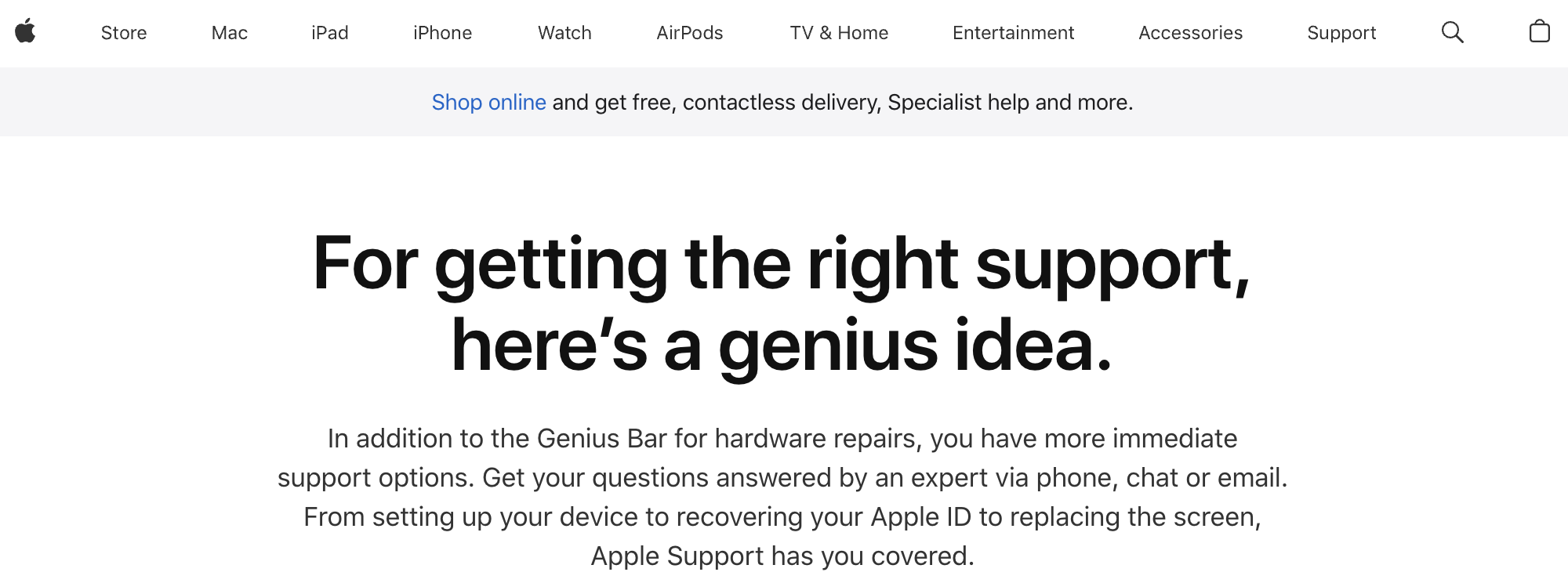
“Today at Apple” sessions provide personalized, hands-on experiences with products, ensuring customers don't just buy devices but understand them. iCloud, a cornerstone of Apple's ecosystem, ensures a unified experience across devices, from iPads to Macs. Essentially, wherever and however you interact with Apple, you're met with a unified, high-quality experience.
Microsoft
Microsoft, a tech giant with a vast social media footprint, faced the challenge of managing an overwhelming 115 million mentions annually.
It was essential for them to sieve through this pile of data to identify meaningful interactions. But with disparate tools and fragmented workflows, their community management team of 75 was entangled in a jigsaw of data points with no clear picture. Microsoft chose to use a unified, centralized solution to take their experiences from merely dabbling in social to mastering it at an impressive scale. This move empowered them to manage social publishing, drive engagement and gain insights efficiently.
That’s how Microsoft revolutionized its Customer Experience Center. They chose to truly connect — one person at a time or a thousand at once. Read more about it here.
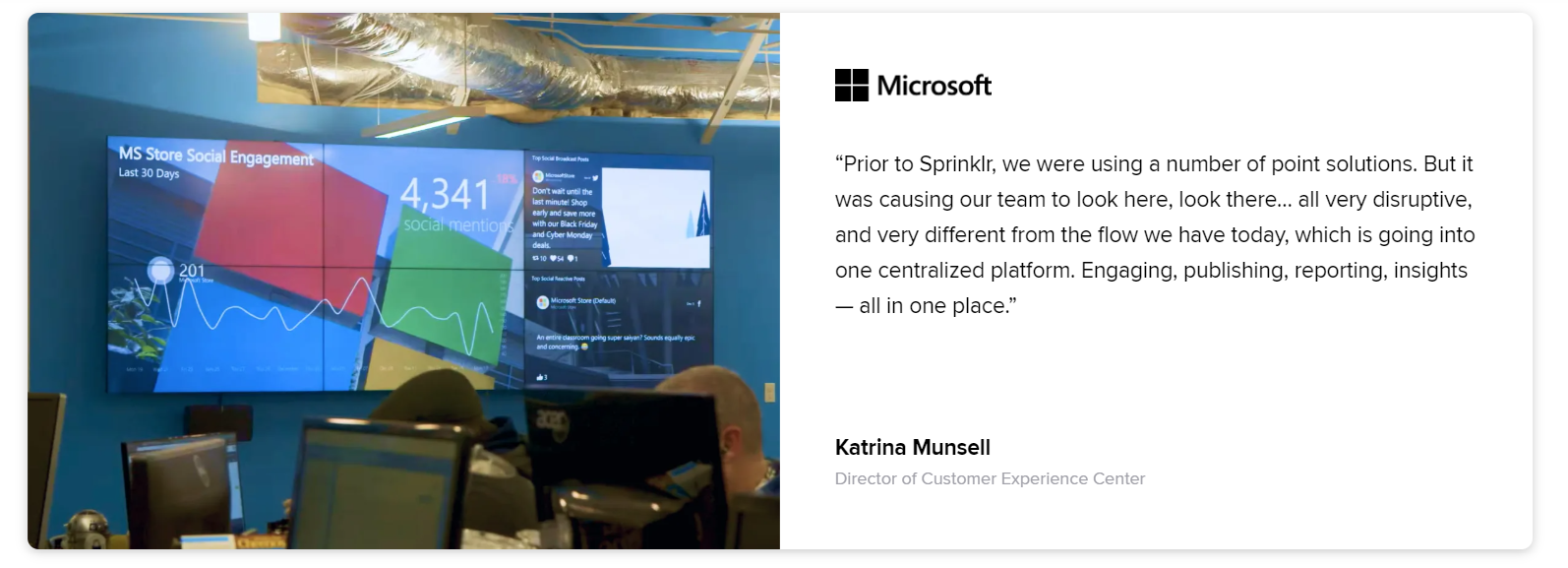
Create an omnichannel customer experience with Sprinklr
The first step in delivering an omnichannel customer experience is to eliminate data silos. Sprinklr does this by unifying customer experience data from 30+ messaging, live chat, social, and app channels on a single platform.
Sprinklr’s industry-leading AI models transform this raw data into actionable insights for your brand —
analyzing it to make 10 billion AI predictions every day
handling over 15 million monthly customer cases,
managing over 2 billion profiles across all digital channels
As the world's only Unified Customer Experience Management (Unified-CXM) platform, Sprinklr empowers you to track every action across all channels, adjust workflows as needed, and define user roles with adjustable views and permissions. Sprinklr’s Unified-CXM platform fuses our four integrated, purpose-built product suites tailored to elevate your omnichannel experiences across sales, marketing, research and support.
Sprinklr Insights decodes vast consumer data for smarter strategies.
Sprinklr Service transforms customer engagement; take a proactive, digital-first approach, always with a personal touch
Sprinklr Marketing to shift social media from mere chat to impactful, efficient content creation, tailored for vast audiences
Sprinklr Social ensures brand consistency across myriad digital touchpoints, all while crafting genuine relationships.
Seamlessly build delightful omnichannel campaigns, ensuring a unified customer journey every step of the way. Book your free demo today.
Frequently Asked Questions
related products
Thank you for contacting us.
A Sprinklr representative will be in touch with you shortly.
Contact us today, and we'll create a customized proposal that addresses your unique business needs.
Request a Demo
Welcome Back,
No need to fill out any forms — you're all set.



